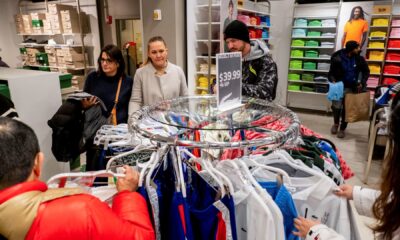MARKETING
How Land O’Lakes Found a Mission Greater Than Sales

It was a powerful moment. A CNN+ interviewer asks Beth Ford, “What is the purpose of your life?”
She replies: “I hope I will know success by the number of lives I’ve touched. I hope by changing somebody’s story, by helping them succeed – if that’s what my life is and ends up being, that is going to be the best joy of my life.”
Beth is CEO of Land O’Lakes, a farmer-member-owned company with businesses focused on agricultural production and consumer foods, including the famous butter.
She shares with CNN+ what she sees beyond business in that rural landscape: “I cannot tell you how painful it is to watch a family have to struggle or to hear that they’re doing their hardest and to worry how they’re going to feed their own kids.
“Seventy-eight percent of the counties in America that index as food-insecure are in rural America … And it’s just not right. I don’t see why we say it’s someone else’s problem. This is an American issue. It leaves us less secure.”
How did Beth and Land O’Lakes become such fierce advocates for the American farmer? And how did that lead to the CNN+ interview? That story was told by Kim Olson, Land O’Lakes chief communications officer, at Content Marketing World.
Let’s rewind and start from the beginning.
Brand role, brand purpose
While the work in earned media and communications started as soon as Beth was named CEO, it more recently has been amplified and framed in enterprise purpose work led by Chief Marketing Officer Heather Malenshek.
Kim explains: “Less than 1% of the population is involved in agriculture, but 100% of us have to eat. We used to talk about farmers around the dinner table. Someone had an uncle or cousin that was out on the farm. Not anymore.”
Land O’Lakes determined the following:
- Brand belief: Farmers are the entrepreneurs who truly change the world for the better.
- Brand role: Magnify and champion farming’s true potential through relentless cooperation.
- Brand purpose: Put farmers and retailers at the heart of creating a better world.
- Brand impact: Sustainable futures, vibrant rural communities, and safe and plentiful food supply.

Create a persona of the brand
To personalize the brand purpose and make it more tangible, the company created a persona – Maverick Advocate.
Maverick Advocate portrays bravery and resiliency, using its brand voice for good. The character does not destroy a system but makes it better. Kim says Maverick Advocate leads with the kindness and compassion that resilient, kind, and family-oriented farmers appreciate.
Beth, who became the president and CEO in July 2018, in many ways embodies the Maverick Advocate character. A few months after she started, she dined with farmer members who talked about their day-to-day lives. Beth asked how they made use of opportunities for additional economic, educational, and health-care digital resources. To her surprise, the farmers said they often didn’t have opportunities because they don’t have access to internet connectivity.
@LandOLakesInc CEO heard farmers didn’t have access to the internet, prompting the brand’s American Connection Project according to @BethFordLOL via @kim_l_olson @dshiao @CMIContent. Click To Tweet
Further research revealed over 42 million Americans lack access to broadband internet, Kim tells the Content Marketing World crowd.
Land O’Lakes had found its communications platform, closing the digital divide by expanding broadband access.
Develop a multi-year strategy
Kim helped conceive a three-year plan around this digital divide initiative. Beth served as the effort’s primary voice:

The first year focused on building awareness of Beth as the new CEO and the Land O’Lakes brand. The second year centered on driving advocacy for closing the digital divide. Building on the success of years one and two, the third year focused on performance – expanding the strong CEO halo to enterprise and executive influence.
Let’s explore each phase further.
Year 1: Awareness
The awareness phase focused on high-profile speaking events, media opportunities, and op-ed articles, Kim explains. In one of Beth’s first appearances, she spoke at the Economic Club of Chicago. Beth discovered people were receptive to her message and largely didn’t know about the issue.
On the communications side, Kim focused on forming a strong, unified, and consistent message across media placements in local, regional, and national outlets. She says when working with the media, momentum is key. A few initial placements lead to more, usually more high-profile placements.
@LandOLakesInc @kim_l_olson says momentum is key in media placements. That’s what eventually brought CBS’ @60Minutes @LesleyRStahl to them, says @dshiao via @CMIContent. Click To Tweet
CBS News correspondent Leslie Stahl heard Beth speak. Her staff contacted Land O’Lakes to invite Beth to appear on 60 Minutes.
Kim worked with Beth to convince the broader leadership team about the opportunity. (After all, a story on 60 Minutes isn’t always that flattering for a company.)

They invited 60 Minutes to a member’s farm in Pennsylvania to see the dairy operation. They involved Land O’Lakes chief technology officer Teddy Bekele to discuss broadband and the digital divide. The team helped 60 Minutes tell the story of what’s happening to farmers in rural America.
The program aired in October 2019 and it was a big success. It generated a lot of awareness and opened the door to more opportunities.
Year two: Advocacy
In year two, Land O’Lakes launched the American Connection Project (ACP) initiative to generate awareness and advocacy to address the digital divide. An ACP policy coalition included 177 companies from multiple industries that all agreed to the importance of broadband access for rural communities.
Joining with the 140+ orgs in the American Connection Project Broadband Coalition, we sent a letter to @POTUS + congressional leaders urging them to invest in broadband to close the #digitaldivide and ensure that we #ConnectAllStudents: https://t.co/E016dlBrZs pic.twitter.com/ldzpVmEjI2
— Common Sense Media (@CommonSense) January 29, 2021
Member organizations include Cleveland Clinic, Microsoft, and Purdue University. In this phase, Land O’Lakes generated notable earned media placements. Sample headlines:
- Land O’Lakes Played Key Role in Securing $65B for Federal Broadband Funding
- Land O’Lakes, Inc. Teams up with Center on Rural Innovation To Launch American Connection Communities
- Wolf Leads Bipartisan Effort in Calling on President, Congressional Leaders To Invest in Broadband Internet Access
These efforts culminated in November 2021, when Beth joined others on the White House lawn when the president signed the historic infrastructure bill:
This is a historic moment for our country, @LandOLakesInc farmer- and member-owners and their communities. Thank you to everyone who worked together on a bipartisan basis to get these critical investments in roads, bridges and #broadband to the President’s desk. pic.twitter.com/g1N8rLPB7L
— Beth Ford (@BethFordLOL) November 15, 2021
Year 3: Action
During the pandemic, broadband access became more essential, heightening the seriousness of the digital divide. The Land O’Lakes team and their members, partners, and the coalition took action. Tina May, Beth’s chief of staff and vice president, rural services, led efforts to expand the American Connection Project.
Many provided free Wi-Fi access to their networks in their parking lots. The American Connection Project members and other Land O’Lakes partners rallied to provide free Wi-Fi access. In all, people could access free Wi-Fi at 3,000 locations.
The action didn’t stop there. The American Connection Project added more initiatives. American Connection Corps brings in young fellows who go back into rural communities to talk about digital connectivity and help workers improve their skills. The fellows also provide planning and consulting to these workers. The first initiative took place in Aberdeen, South Dakota.
Follow-on phase: enterprise-wide expansion
In a follow-on phase, Beth and members of the executive team elevated the collective voice and influence of Land O’Lakes to the broader world of business. Their earned media coverage featured numerous members of the C-suite, with placements in MarketWatch, VentureBeat, National Rural Business Summit, and.

Beth now sits on The Business Roundtable, a nonprofit association eWeek based in Washington, D.C., whose members are chief executive officers of major U.S. companies. Beth has earned coverage in broader business publications, such as Fast Company and TED.
Be the next Land O’Lakes
At first blush, you might think, “This is a great story, but Land O’Lakes is a Fortune 500 company and this doesn’t apply to me.”
But it does. You can apply several things from this story to communications in any-sized company.
Land O’Lakes strategy was about the audience, not sales. How can you help your target audience’s lives?
Land O’Lakes didn’t execute its mission alone. It partnered with over 175 companies to join the cause. What businesses, organizations, and people could help you achieve your audience-focused mission?
The other key to being like Land O’Lakes? Remember, they took over three years to execute it. Create a detailed plan but make sure it’s long-term.
HANDPICKED RELATED CONTENT:
Cover image by Joseph Kalinowski/Content Marketing Institute
MARKETING
Ecommerce evolution: Blurring the lines between B2B and B2C

Understanding convergence
B2B and B2C ecommerce are two distinct models of online selling. B2B ecommerce is between businesses, such as wholesalers, distributors, and manufacturers. B2C ecommerce refers to transactions between businesses like retailers and consumer brands, directly to individual shoppers.
However, in recent years, the boundaries between these two models have started to fade. This is known as the convergence between B2B and B2C ecommerce and how they are becoming more similar and integrated.
Source: White Paper: The evolution of the B2B Consumer Buyer (ClientPoint, Jan 2024)
What’s driving this change?
Ever increasing customer expectations
Customers today expect the same level of convenience, speed, and personalization in their B2B transactions as they do in their B2C interactions. B2B buyers are increasingly influenced by their B2C experiences. They want research, compare, and purchase products online, seamlessly transitioning between devices and channels. They also prefer to research and purchase online, using multiple devices and channels.
Forrester, 68% of buyers prefer to research on their own, online . Customers today expect the same level of convenience, speed, and personalization in their B2B transactions as they do in their B2C interactions. B2B buyers are increasingly influenced by their B2C experiences. They want research, compare, and purchase products online, seamlessly transitioning between devices and channels. They also prefer to research and purchase online, using multiple devices and channels
Technology and omnichannel strategies
Technology enables B2B and B2C ecommerce platforms to offer more features and functionalities, such as mobile optimization, chatbots, AI, and augmented reality. Omnichannel strategies allow B2B and B2C ecommerce businesses to provide a seamless and consistent customer experience across different touchpoints, such as websites, social media, email, and physical stores.
However, with every great leap forward comes its own set of challenges. The convergence of B2B and B2C markets means increased competition. Businesses now not only have to compete with their traditional rivals, but also with new entrants and disruptors from different sectors. For example, Amazon Business, a B2B ecommerce platform, has become a major threat to many B2B ecommerce businesses, as it offers a wide range of products, low prices, and fast delivery
“Amazon Business has proven that B2B ecommerce can leverage popular B2C-like functionality” argues Joe Albrecht, CEO / Managing Partner, Xngage. . With features like Subscribe-and-Save (auto-replenishment), one-click buying, and curated assortments by job role or work location, they make it easy for B2B buyers to go to their website and never leave. Plus, with exceptional customer service and promotional incentives like Amazon Business Prime Days, they have created a reinforcing loyalty loop.
And yet, according to Barron’s, Amazon Business is only expected to capture 1.5% of the $5.7 Trillion addressable business market by 2025. If other B2B companies can truly become digital-first organizations, they can compete and win in this fragmented space, too.”
If other B2B companies can truly become digital-first organizations, they can also compete and win in this fragmented space
Joe AlbrechtCEO/Managing Partner, XNGAGE
Increasing complexity
Another challenge is the increased complexity and cost of managing a converging ecommerce business. Businesses have to deal with different customer segments, requirements, and expectations, which may require different strategies, processes, and systems. For instance, B2B ecommerce businesses may have to handle more complex transactions, such as bulk orders, contract negotiations, and invoicing, while B2C ecommerce businesses may have to handle more customer service, returns, and loyalty programs. Moreover, B2B and B2C ecommerce businesses must invest in technology and infrastructure to support their convergence efforts, which may increase their operational and maintenance costs.
How to win
Here are a few ways companies can get ahead of the game:
Adopt B2C-like features in B2B platforms
User-friendly design, easy navigation, product reviews, personalization, recommendations, and ratings can help B2B ecommerce businesses to attract and retain more customers, as well as to increase their conversion and retention rates.
According to McKinsey, ecommerce businesses that offer B2C-like features like personalization can increase their revenues by 15% and reduce their costs by 20%. You can do this through personalization of your website with tools like Product Recommendations that help suggest related products to increase sales.
Focus on personalization and customer experience
B2B and B2C ecommerce businesses need to understand their customers’ needs, preferences, and behaviors, and tailor their offerings and interactions accordingly. Personalization and customer experience can help B2B and B2C ecommerce businesses to increase customer satisfaction, loyalty, and advocacy, as well as to improve their brand reputation and competitive advantage. According to a Salesforce report, 88% of customers say that the experience a company provides is as important as its products or services.
Market based on customer insights
Data and analytics can help B2B and B2C ecommerce businesses to gain insights into their customers, markets, competitors, and performance, and to optimize their strategies and operations accordingly. Data and analytics can also help B2B and B2C ecommerce businesses to identify new opportunities, trends, and innovations, and to anticipate and respond to customer needs and expectations. According to McKinsey, data-driven organizations are 23 times more likely to acquire customers, six times more likely to retain customers, and 19 times more likely to be profitable.
What’s next?
The convergence of B2B and B2C ecommerce is not a temporary phenomenon, but a long-term trend that will continue to shape the future of ecommerce. According to Statista, the global B2B ecommerce market is expected to reach $20.9 trillion by 2027, surpassing the B2C ecommerce market, which is expected to reach $10.5 trillion by 2027. Moreover, the report predicts that the convergence of B2B and B2C ecommerce will create new business models, such as B2B2C, B2A (business to anyone), and C2B (consumer to business).
Therefore, B2B and B2C ecommerce businesses need to prepare for the converging ecommerce landscape and take advantage of the opportunities and challenges it presents. Here are some recommendations for B2B and B2C ecommerce businesses to navigate the converging landscape:
- Conduct a thorough analysis of your customers, competitors, and market, and identify the gaps and opportunities for convergence.
- Develop a clear vision and strategy for convergence, and align your goals, objectives, and metrics with it.
- Invest in technology and infrastructure that can support your convergence efforts, such as cloud, mobile, AI, and omnichannel platforms.
- Implement B2C-like features in your B2B platforms, and vice versa, to enhance your customer experience and satisfaction.
- Personalize your offerings and interactions with your customers, and provide them with relevant and valuable content and solutions.
- Leverage data and analytics to optimize your performance and decision making, and to innovate and differentiate your business.
- Collaborate and partner with other B2B and B2C ecommerce businesses, as well as with other stakeholders, such as suppliers, distributors, and customers, to create value and synergy.
- Monitor and evaluate your convergence efforts, and adapt and improve them as needed.
By following these recommendations, B2B and B2C ecommerce businesses can bridge the gap between their models and create a more integrated and seamless ecommerce experience for their customers and themselves.
MARKETING
Streamlining Processes for Increased Efficiency and Results

How can businesses succeed nowadays when technology rules? With competition getting tougher and customers changing their preferences often, it’s a challenge. But using marketing automation can help make things easier and get better results. And in the future, it’s going to be even more important for all kinds of businesses.
So, let’s discuss how businesses can leverage marketing automation to stay ahead and thrive.
Benefits of automation marketing automation to boost your efforts
First, let’s explore the benefits of marketing automation to supercharge your efforts:
Marketing automation simplifies repetitive tasks, saving time and effort.
With automated workflows, processes become more efficient, leading to better productivity. For instance, automation not only streamlines tasks like email campaigns but also optimizes website speed, ensuring a seamless user experience. A faster website not only enhances customer satisfaction but also positively impacts search engine rankings, driving more organic traffic and ultimately boosting conversions.
Automation allows for precise targeting, reaching the right audience with personalized messages.
With automated workflows, processes become more efficient, leading to better productivity. A great example of automated workflow is Pipedrive & WhatsApp Integration in which an automated welcome message pops up on their WhatsApp
within seconds once a potential customer expresses interest in your business.
Increases ROI
By optimizing campaigns and reducing manual labor, automation can significantly improve return on investment.
Leveraging automation enables businesses to scale their marketing efforts effectively, driving growth and success. Additionally, incorporating lead scoring into automated marketing processes can streamline the identification of high-potential prospects, further optimizing resource allocation and maximizing conversion rates.
Harnessing the power of marketing automation can revolutionize your marketing strategy, leading to increased efficiency, higher returns, and sustainable growth in today’s competitive market. So, why wait? Start automating your marketing efforts today and propel your business to new heights, moreover if you have just learned ways on how to create an online business
How marketing automation can simplify operations and increase efficiency
Understanding the Change
Marketing automation has evolved significantly over time, from basic email marketing campaigns to sophisticated platforms that can manage entire marketing strategies. This progress has been fueled by advances in technology, particularly artificial intelligence (AI) and machine learning, making automation smarter and more adaptable.
One of the main reasons for this shift is the vast amount of data available to marketers today. From understanding customer demographics to analyzing behavior, the sheer volume of data is staggering. Marketing automation platforms use this data to create highly personalized and targeted campaigns, allowing businesses to connect with their audience on a deeper level.
The Emergence of AI-Powered Automation
In the future, AI-powered automation will play an even bigger role in marketing strategies. AI algorithms can analyze huge amounts of data in real-time, helping marketers identify trends, predict consumer behavior, and optimize campaigns as they go. This agility and responsiveness are crucial in today’s fast-moving digital world, where opportunities come and go in the blink of an eye. For example, we’re witnessing the rise of AI-based tools from AI website builders, to AI logo generators and even more, showing that we’re competing with time and efficiency.
Combining AI-powered automation with WordPress management services streamlines marketing efforts, enabling quick adaptation to changing trends and efficient management of online presence.
Moreover, AI can take care of routine tasks like content creation, scheduling, and testing, giving marketers more time to focus on strategic activities. By automating these repetitive tasks, businesses can work more efficiently, leading to better outcomes. AI can create social media ads tailored to specific demographics and preferences, ensuring that the content resonates with the target audience. With the help of an AI ad maker tool, businesses can efficiently produce high-quality advertisements that drive engagement and conversions across various social media platforms.
Personalization on a Large Scale
Personalization has always been important in marketing, and automation is making it possible on a larger scale. By using AI and machine learning, marketers can create tailored experiences for each customer based on their preferences, behaviors, and past interactions with the brand.
This level of personalization not only boosts customer satisfaction but also increases engagement and loyalty. When consumers feel understood and valued, they are more likely to become loyal customers and brand advocates. As automation technology continues to evolve, we can expect personalization to become even more advanced, enabling businesses to forge deeper connections with their audience. As your company has tiny homes for sale California, personalized experiences will ensure each customer finds their perfect fit, fostering lasting connections.
Integration Across Channels
Another trend shaping the future of marketing automation is the integration of multiple channels into a cohesive strategy. Today’s consumers interact with brands across various touchpoints, from social media and email to websites and mobile apps. Marketing automation platforms that can seamlessly integrate these channels and deliver consistent messaging will have a competitive edge. When creating a comparison website it’s important to ensure that the platform effectively aggregates data from diverse sources and presents it in a user-friendly manner, empowering consumers to make informed decisions.
Omni-channel integration not only betters the customer experience but also provides marketers with a comprehensive view of the customer journey. By tracking interactions across channels, businesses can gain valuable insights into how consumers engage with their brand, allowing them to refine their marketing strategies for maximum impact. Lastly, integrating SEO services into omni-channel strategies boosts visibility and helps businesses better understand and engage with their customers across different platforms.
The Human Element
While automation offers many benefits, it’s crucial not to overlook the human aspect of marketing. Despite advances in AI and machine learning, there are still elements of marketing that require human creativity, empathy, and strategic thinking.
Successful marketing automation strikes a balance between technology and human expertise. By using automation to handle routine tasks and data analysis, marketers can focus on what they do best – storytelling, building relationships, and driving innovation.
Conclusion
The future of marketing automation looks promising, offering improved efficiency and results for businesses of all sizes.
As AI continues to advance and consumer expectations change, automation will play an increasingly vital role in keeping businesses competitive.
By embracing automation technologies, marketers can simplify processes, deliver more personalized experiences, and ultimately, achieve their business goals more effectively than ever before.
MARKETING
Will Google Buy HubSpot? | Content Marketing Institute

Google + HubSpot. Is it a thing?
This week, a flurry of news came down about Google’s consideration of purchasing HubSpot.
The prospect dismayed some. It delighted others.
But is it likely? Is it even possible? What would it mean for marketers? What does the consideration even mean for marketers?
Well, we asked CMI’s chief strategy advisor, Robert Rose, for his take. Watch this video or read on:
Why Alphabet may want HubSpot
Alphabet, the parent company of Google, apparently is contemplating the acquisition of inbound marketing giant HubSpot.
The potential price could be in the range of $30 billion to $40 billion. That would make Alphabet’s largest acquisition by far. The current deal holding that title happened in 2011 when it acquired Motorola Mobility for more than $12 billion. It later sold it to Lenovo for less than $3 billion.
If the HubSpot deal happens, it would not be in character with what the classic evil villain has been doing for the past 20 years.
At first glance, you might think the deal would make no sense. Why would Google want to spend three times as much as it’s ever spent to get into the inbound marketing — the CRM and marketing automation business?
At a second glance, it makes a ton of sense.
I don’t know if you’ve noticed, but I and others at CMI spend a lot of time discussing privacy, owned media, and the deprecation of the third-party cookie. I just talked about it two weeks ago. It’s really happening.
All that oxygen being sucked out of the ad tech space presents a compelling case that Alphabet should diversify from third-party data and classic surveillance-based marketing.
Yes, this potential acquisition is about data. HubSpot would give Alphabet the keys to the kingdom of 205,000 business customers — and their customers’ data that almost certainly numbers in the tens of millions. Alphabet would also gain access to the content, marketing, and sales information those customers consumed.
Conversely, the deal would provide an immediate tip of the spear for HubSpot clients to create more targeted programs in the Alphabet ecosystem and upload their data to drive even more personalized experiences on their own properties and connect them to the Google Workspace infrastructure.
When you add in the idea of Gemini, you can start to see how Google might monetize its generative AI tool beyond figuring out how to use it on ads on search results pages.
What acquisition could mean for HubSpot customers
I may be stretching here but imagine this world. As a Hubspoogle customer, you can access an interface that prioritizes your owned media data (e.g., your website, your e-commerce catalog, blog) when Google’s Gemini answers a question).
Recent reports also say Google may put up a paywall around the new premium features of its artificial intelligence-powered Search Generative Experience. Imagine this as the new gating for marketing. In other words, users can subscribe to Google’s AI for free, but Hubspoogle customers can access that data and use it to create targeted offers.
The acquisition of HubSpot would immediately make Google Workspace a more robust competitor to Microsoft 365 Office for small- and medium-sized businesses as they would receive the ADDED capability of inbound marketing.
But in the world of rented land where Google is the landlord, the government will take notice of the acquisition. But — and it’s a big but, I cannot lie (yes, I just did that). The big but is whether this acquisition dance can happen without going afoul of regulatory issues.
Some analysts say it should be no problem. Others say, “Yeah, it wouldn’t go.” Either way, would anybody touch it in an election year? That’s a whole other story.
What marketers should realize
So, what’s my takeaway?
It’s a remote chance that Google will jump on this hard, but stranger things have happened. It would be an exciting disruption in the market.
The sure bet is this. The acquisition conversation — as if you needed more data points — says getting good at owned media to attract and build audiences and using that first-party data to provide better communication and collaboration with your customers are a must.
It’s just a matter of time until Google makes a move. They might just be testing the waters now, but they will move here. But no matter what they do, if you have your customer data house in order, you’ll be primed for success.
HANDPICKED RELATED CONTENT:
Cover image by Joseph Kalinowski/Content Marketing Institute
-

 MARKETING6 days ago
MARKETING6 days agoRoundel Media Studio: What to Expect From Target’s New Self-Service Platform
-

 SEO6 days ago
SEO6 days agoGoogle Limits News Links In California Over Proposed ‘Link Tax’ Law
-
SEARCHENGINES6 days ago
Daily Search Forum Recap: April 12, 2024
-

 SEO5 days ago
SEO5 days ago10 Paid Search & PPC Planning Best Practices
-

 SEARCHENGINES5 days ago
SEARCHENGINES5 days agoGoogle Core Update Volatility, Helpful Content Update Gone, Dangerous Google Search Results & Google Ads Confusion
-

 SEO7 days ago
SEO7 days agoGoogle Unplugs “Notes on Search” Experiment
-

 MARKETING6 days ago
MARKETING6 days ago2 Ways to Take Back the Power in Your Business: Part 2
-

 PPC6 days ago
PPC6 days agoCritical Display Error in Brand Safety Metrics On Twitter/X Corrected













You must be logged in to post a comment Login